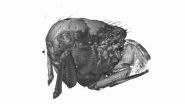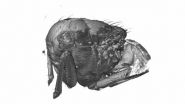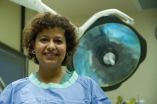(Press-News.org) Scientists have used one of the brightest lights in the Universe to expose the biochemical structure of a 50 million-year-old fossil plant to stunning visual effect.
The team of palaeontologists, geochemists and physicists investigated the chemistry of exceptionally preserved fossil leaves from the Eocene-aged 'Green River Formation' of the western United States by bombarding the fossils with X-rays brighter than a million suns produced by synchrotron particle accelerators.
Researchers from Britain's University of Manchester and Diamond Light Source and the Stanford Synchrotron Radiation Lightsource in the US have published their findings, along with amazing images, in Metallomics; one of the images is featured on the cover of the latest edition of the Royal Society of Chemistry journal.
Lead author Dr Nicholas Edwards, a postdoctoral researcher at The University of Manchester, said: "The synchrotron has already shown its potential in teasing new information from fossils, in particular our group's previous work on pigmentation in fossil animals. With this study, we wanted to use the same techniques to see whether we could extract a similar level of biochemical information from a completely different part of the tree of life.
"To do this we needed to test the chemistry of the fossil plants to see if the fossil material was derived directly from the living organisms or degraded and replaced by the fossilisation process.
"We know that plant chemistry can be preserved over hundreds of millions of years – this preserved chemistry powers our society today in the form of fossil fuels. However, this is just the 'combustible' part; until now no one has completed this type of study of the other biochemical components of fossil plants, such as metals."
By combining the unique capabilities of two synchrotron facilities, the team were able to produce detailed images of where the various elements of the periodic table were located within both living and fossil leaves, as well as being able to show how these elements were combined with other elements.
The work shows that the distribution of copper, zinc and nickel in the fossil leaves was almost identical to that in modern leaves. Each element was concentrated in distinct biological structures, such as the veins and the edges of the leaves, and the way these trace elements and sulphur were attached to other elements was very similar to that seen in modern leaves and plant matter in soils.
Co-author Professor Roy Wogelius, from Manchester's School of Earth, Atmospheric and Environmental Sciences, said: "This type of chemical mapping and the ability to determine the atomic arrangement of biologically important elements, such as copper and sulphur, can only be accomplished by using a synchrotron particle accelerator.
"In one beautiful specimen, the leaf has been partially eaten by prehistoric caterpillars – just as modern caterpillars feed – and their feeding tubes are preserved on the leaf. The chemistry of these fossil tubes remarkably still matches that of the leaf on which the caterpillars fed."
The data from a suite of other techniques has led the team to conclude that the chemistry of the fossil leaves is not wholly sourced from the surrounding environment, as has previously been suggested, but represents that of the living leaves. Another modern-day connection suggests a way in which these specimens are so beautifully preserved over millions of years.
Manchester palaeontologist and co-author Dr Phil Manning said: "We think that copper may have aided preservation by acting as a 'natural' biocide, slowing down the usual microbial breakdown that would destroy delicate leaf tissues. This property of copper is used today in the same wood preservatives that you paint on your garden fence before winter approaches."
INFORMATION:
Notes for editors:
A copy of the paper, 'Leaf Metallome Preserved Over 50 Million Years,' published in the Royal Society of Chemistry journal Metallomics, as well as images of the leaf, are available on request.
Additional quotes from the paper's co-authors for use by the media:
Stanford's Dr Uwe Bergmann, the team physicist, said: "Part of what I do involves detailed measurements of the physics of how plants actually harness light energy using transition metals. Here, we are able to show what metals were present, and where, within extremely old plants- and this just may let us understand, eventually, how the complicated physics of life has developed over long periods of time."
Dr Bart van Dongen, a University of Manchester geochemist, said: "There is a sharp contrast in the chemistry of the fossils from that of the rock in which they are entombed – this is true for both the trace metals and the organic compounds. The organic part of the chemistry clearly shows a plant-derived component."
Dr Nicholas Edwards added: "This opens up the possibility to study part of the biochemistry of ancient plants, so in the future, it may enable us observe the changes, if any, in the use of metals by the plant kingdom through geological time."
Million suns shed light on fossilized plant
2014-03-26
ELSE PRESS RELEASES FROM THIS DATE:
Male Eurasian jays know that their female partners' desires can differ from their own
2014-03-26
Knowing what another person wants is not a trivial issue, particularly when the other's desires are different from our own. The ability to disengage from our own desire to cater to someone else's wishes is thought to be a unique feature of human cognition.
New research challenges this assumption. Despite wanting something different to eat, male Eurasian jays can disengage from their own current desire in order to feed the female what she wants even when her desires are different to his. The study, which was funded by the BBSRC, is published today in the Royal Society ...
Study is first to provide direct evidence that response of unborn children to glucose is associated with mother's insulin sensitivity
2014-03-26
A study published in Diabetologia (the journal of the European Association for the Study of Diabetes) is the first to provide direct evidence that fetal brain response to a dose of sugar given orally to its mother is associated with the mother's insulin sensitivity. This may indicate that the risk of subsequent obesity and diabetes may be pre-programmed in the womb. The study is by Dr Hubert Preissl and Dr Andreas Fritsche, University of Tübingen, Germany and German Center for Diabetes Research (DZD), Neuherberg, Germany, and colleagues.
Diabetes or obesity in the mother ...
Clean cooking fuel and improved kitchen ventilation linked to less lung disease
2014-03-25
Improving cooking fuels and kitchen ventilation is associated with better lung function and reduced chronic obstructive pulmonary disease (COPD), according to research published in this week's PLOS Medicine. The study, led by Pixin Ran from the Guanzhou Medical University, China, followed 996 villagers from southern China for 9 years to examine the effects of cleaner fuels and better kitchen ventilation on lung function and disease.
An estimated 3 billion people worldwide heat their homes and cook by burning biomass such as wood or animal dung. The resulting indoor air ...
X-rays film inside live flying insects -- in 3D
2014-03-25
VIDEO:
This video shows the insect thorax reconstructed from
tomograms and highlights the external movements of the thorax
and the location of the indirect power and steering muscles.
Click here for more information.
Scientists have used a particle accelerator to obtain high-speed 3D X-ray visualizations of the flight muscles of flies. The team from Oxford University, Imperial College, and the Paul Scherrer Institute (PSI) developed a groundbreaking new CT scanning technique ...
A way to end recurrent urinary tract infections? Study with mice gives hope
2014-03-25
(SALT LAKE CITY)—Millions of people worldwide – mostly women – suffer from recurrent urinary tract infections (UTIs) that seriously degrade their health and quality of life. Antibiotics treat individual infections, but preventing recurrent ones largely has been unattainable because of the way bacteria lodge in the inner layers of the bladder and quietly hide from drugs that can kill them.
In new studies with mice, however, researchers led by University of Utah microbiologists have shown that when chitosan, an FDA-approved compound for pharmaceutical, agricultural and ...
EEG study shows how brain infers structure, rules when learning
2014-03-25
PROVIDENCE, R.I. [Brown University] — In life, many tasks have a context that dictates the right actions, so when people learn to do something new, they'll often infer cues of context and rules. In a new study, Brown University brain scientists took advantage of that tendency to track the emergence of such rule structures in the frontal cortex — even when such structure was not necessary or even helpful to learn — and to predict from EEG readings how people would apply them to learn new tasks speedily.
Context and rule structures are everywhere. They allow an iPhone user ...
In-fly movie: 3D video from inside flying insects
2014-03-25
VIDEO:
This is a 3D movie of a blowfly's flight muscles moving created by Oxford University and Imperial scientists using a new X-ray scanning technique.
Click here for more information.
The flight muscles moving inside flies have been filmed for the first time using a new 3D X-ray scanning technique.
3D movies of the muscles were created by a team from Oxford University, Imperial College London, and the Paul Scherrer Institute (PSI), using the PSI's Swiss Light Source, ...
Strictly limiting hours surgical residents can work has not improved patient safety
2014-03-25
TORONTO, March 25, 2014--Strictly limiting the number of hours surgical residents can work has not improved patient outcomes but may have increased complications for some patients and led to higher failure rates on certification exams, a research paper concludes.
Traditionally, doctors in the residency phase of their training spent very long hours in a hospital –often around-the-clock--so they could see a wide variety and high volume of patients. In the last 10 years, health authorities started limiting those hours in the hopes of improving patient safety and the education ...
Unravelling nerve-cell death in rare children's disease
2014-03-25
LA JOLLA, Calif., March 25, 2014 — A team of scientists, led by Stuart Lipton, M.D., Ph.D., professor and director of the Neuroscience and Aging Research Center at Sanford-Burnham Medical Research Institute (Sanford-Burnham), recently discovered why cerebellar granule cell neurons in patients suffering from ataxia-telangiectasia (A-T) were unable to repair DNA damage and thus died.
A-T is a hereditary condition that begins early in childhood, and causes a gradual loss of certain nerve cells in the cerebellum of the brain. A-T occurs in about 1 in 40,000 births, with symptoms ...
Brain differences in college-aged occasional drug users
2014-03-25
Researchers at the University of California, San Diego School of Medicine have discovered impaired neuronal activity in the parts of the brain associated with anticipatory functioning among occasional 18- to 24-year-old users of stimulant drugs, such as cocaine, amphetamines and prescription drugs such as Adderall.
The brain differences, detected using functional magnetic resonance imaging (fMRI), are believed to represent an internal hard wiring that may make some people more prone to drug addiction later in life.
Among the study's main implications is the possibility ...


